
- Home
- Travel Packages
- Top Destination
-
Travel Attraction
By Category
Top Attraction

- Travel Agents
- Car Rentals
- Hotels

About The Jama Masjid The Jama Masjid in Agra is a beautiful mosque that was built by Shah Jahan, the Mughal emperor known for constructing the iconic Taj Mahal. Completed in 1648, this grand mosque is one of the largest in India and is a significant symbol of Mughal architecture. It is said that the Jama Masjid was built to serve as a congregational mosque for the emperor and his courtiers. Architecture of Jama Masjid The Jama Masjid showcases stunning Mughal architecture with its red sandstone exterior and intricate white marble detailing. The mosque has three large domes, four minarets, and a spacious courtyard that can accommodate thousands of worshipers. The interior is adorned with exquisite carvings, calligraphy, and geometric patterns that reflect the skills of Mughal artisans. History The Jama Masjid has a rich history that dates back to the Mughal era. It was constructed during the reign of Shah Jahan, who was known for his love of grand architectural projects. The mosque was built to symbolize the emperor's power and to provide a place of worship for the Muslim community in Agra. Over the years, the Jama Masjid has stood as a testament to the Mughal dynasty's architectural prowess and cultural influence. Best Time To Visit The best time to visit the Jama Masjid in Agra is during the early morning or late afternoon when the weather is pleasant and the light is perfect for capturing the beauty of the mosque. It is advisable to avoid visiting during peak hours or on Fridays, as the mosque can get crowded with worshipers. How To Reach The Jama Masjid is located in the heart of Agra and is easily accessible by various modes of transportation. Visitors can take a taxi, auto-rickshaw, or cycle rickshaw to reach the mosque from any part of the city. The nearest railway station is Agra Cantt, which is well-connected to major cities in India. The nearest airport is Agra Airport, which has flights to and from Delhi, Mumbai, and other major cities. Visitor Tips When visiting the Jama Masjid, it is important to dress modestly and cover your head before entering the mosque. It is also advisable to remove your shoes before stepping onto the marble floors. Photography is allowed inside the mosque, but it is recommended to be respectful of worshipers and the sanctity of the space. Lastly, be cautious of touts and vendors outside the mosque who may try to sell you souvenirs or services. Overall, the Jama Masjid in Agra is a must-visit destination for those interested in Mughal architecture and history. Its grandeur and beauty make it a significant landmark in the city, and a visit to this majestic mosque is sure to leave a lasting impression on any traveler.
Explore More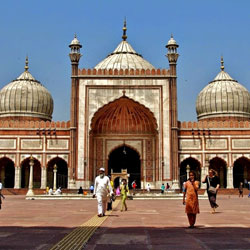
About The Jama Masjid The Jama Masjid in Lucknow is one of the most prominent landmarks in the city and is a significant religious site for Muslims. Built in the 19th century by Sultan Ahmed Shah, the Jama Masjid is a beautiful example of Mughal architecture and is known for its grandeur and historical significance. Architecture of Jama Masjid The Jama Masjid in Lucknow is a stunning blend of Mughal and Persian architectural styles. The mosque is built with red sandstone and features intricate carvings and beautiful domes. The main prayer hall is adorned with delicate marble work, while the courtyard is spacious and peaceful, making it a perfect place for prayer and reflection. The Jama Masjid also has four minarets that add to its grandeur and beauty. History The Jama Masjid was built in 1839 by Sultan Ahmed Shah, the third king of the Awadh region. The mosque was constructed to serve as a central place of worship for the city's Muslim population and has since become a symbol of religious tolerance and harmony in Lucknow. Over the years, the Jama Masjid has stood as a testament to the rich cultural heritage of the region and continues to be a popular destination for both locals and tourists. Best Time To Visit The best time to visit the Jama Masjid in Lucknow is during the early morning or late afternoon when the weather is cooler and the light is perfect for capturing the beauty of the mosque. The mosque is open to visitors throughout the year, but it is recommended to avoid visiting during prayer times to respect the religious practices of the worshippers. How To Reach The Jama Masjid is located in the heart of Lucknow, making it easily accessible by both public and private transportation. Visitors can take a taxi or auto-rickshaw to reach the mosque, or they can opt for local buses that run throughout the city. The mosque is also within walking distance from many hotels and tourist attractions in Lucknow, making it a convenient stop for those exploring the city. Visitor Tips When visiting the Jama Masjid, it is important to dress modestly and respectfully, as it is a religious site. Visitors should also remove their shoes before entering the mosque and avoid taking photographs during prayer times. It is recommended to visit the mosque with a guide who can provide insights into its history and significance. Additionally, visitors should be mindful of the cultural practices and customs of the region and be respectful of the worshippers at the mosque.
Explore More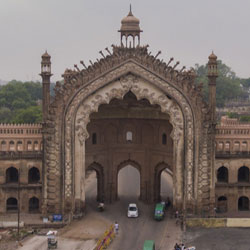
About The Rumi Darwaza The Rumi Darwaza is an iconic historical monument located in Lucknow, Uttar Pradesh, India. It is also known as the Turkish Gate and was built in 1784 by Nawab Asaf-ud-Daula, the fourth Nawab of Awadh. The Rumi Darwaza stands as a symbol of Lucknow's rich cultural heritage and architectural prowess. It is a stunning example of Mughal architecture and is one of the most well-preserved gateways in the country. Architecture of Rumi Darwaza The Rumi Darwaza is an imposing structure that stands at a height of 60 feet. It is made of bricks and lime mortar, and its design draws inspiration from Turkish architecture. The gateway is adorned with intricate floral designs and calligraphy, adding to its grandeur. The Rumi Darwaza has a double-storeyed facade with a large arched opening on the ground floor and smaller arched windows on the upper floor. The gateway is topped with an octagonal chhatri (umbrella-like dome) that adds to its architectural beauty. History The Rumi Darwaza was built during the reign of Nawab Asaf-ud-Daula to provide relief to the famine-stricken population of Lucknow. The gateway was named 'Rumi' which means Roman, as it was believed to be inspired by the Sublime Porte in Constantinople (present-day Istanbul). The construction of the Rumi Darwaza also served as a means to generate employment for the local populace during the period of distress. Over the years, the Rumi Darwaza has witnessed the ebb and flow of history and has stood as a silent witness to the changing times. Best Time To Visit The best time to visit the Rumi Darwaza is during the winter months from October to March when the weather is pleasant and suitable for sightseeing. The cool temperatures make it ideal for exploring the monument and enjoying its architectural splendor. Additionally, visiting early in the morning or late in the evening allows you to avoid the crowds and experience the tranquil beauty of the Rumi Darwaza. It is advisable to check the local weather conditions before planning your visit to ensure a comfortable and enjoyable experience. How To Reach The Rumi Darwaza is located in the heart of Lucknow city and is easily accessible by various modes of transportation. If you are traveling by air, the nearest airport is Chaudhary Charan Singh International Airport, which is approximately 15 kilometers away from the monument. You can hire a taxi or take a local bus to reach the Rumi Darwaza from the airport. If you are traveling by train, Lucknow Junction Railway Station is the nearest railhead, located about 5 kilometers from the gateway. From the railway station, you can hire a cab or take a local bus to reach the Rumi Darwaza. Visitor Tips 1. Photography: Photography is allowed at the Rumi Darwaza, so make sure to capture the beauty of the monument and preserve your memories. 2. Respect the Heritage: While visiting the Rumi Darwaza, it is important to respect the heritage and maintain the cleanliness of the surroundings. Avoid littering and follow the guidelines set by the authorities. 3. Guided Tours: To learn more about the history and architecture of the Rumi Darwaza, consider taking a guided tour with a knowledgeable guide who can provide insights and interesting facts about the monument. 4. Comfortable Footwear: The Rumi Darwaza has a large area to explore, so wear comfortable footwear to make your visit more enjoyable and hassle-free. 5. Local Cuisine: After exploring the Rumi Darwaza, don't forget to savor the local cuisine of Lucknow, known for its delectable dishes such as kebabs, biryanis, and sweets. Visiting the Rumi Darwaza is a journey back in time to experience the grandeur and architectural marvels of the bygone era. The monument stands as a testament to the artistic and cultural legacy of Lucknow, making it a must-visit destination for history buffs and architecture enthusiasts.
Explore More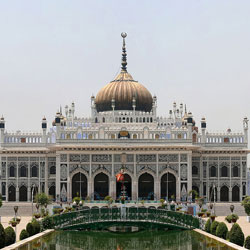
About The Chhota Imambara The Chhota Imambara, also known as Imambara Hussainabad Mubarak, is a popular tourist attraction located in Lucknow, Uttar Pradesh, India. It was built by Mohammed Ali Shah in 1838 as a place for religious gatherings and commemorating events in Shia Islam. The complex includes a mosque, a stepwell, and a stunning garden, making it a must-visit destination for history enthusiasts and architectural aficionados. Architecture of Chhota Imambara The Chhota Imambara is renowned for its exquisite Mughal architecture, featuring intricate designs and beautiful embellishments. The main building is adorned with glistening chandeliers, Belgian mirrors, and exquisite calligraphy. The central hall, also known as Azakhana, is where the religious ceremonies and gatherings take place. The complex also includes a stunning water body known as Satkhanda, which adds to the charm of the overall architecture. History The Chhota Imambara was built by Mohammed Ali Shah, the third Nawab of Awadh, in 1838. The construction of the monument was a way for the Nawab to provide employment to the people during a severe famine that struck the region. The complex served as a place for religious and social gatherings, as well as a mausoleum for the Nawab and his family members. Over the years, the Chhota Imambara has become a symbol of Lucknow's rich cultural heritage. Best Time To Visit The best time to visit the Chhota Imambara is during the winter months, from October to March, when the weather is pleasant and ideal for exploring the monument and its surroundings. The Chhota Imambara is especially beautiful during festivals like Muharram and Eid, when the complex is adorned with lights and decorations, creating a festive atmosphere. How To Reach The Chhota Imambara is easily accessible by road, rail, and air. Lucknow has a well-connected airport, the Chaudhary Charan Singh International Airport, which is approximately 14 km away from the monument. The Lucknow Railway Station is about 4 km from the Chhota Imambara, making it convenient for those traveling by train. Additionally, local buses and taxis are available for commuting within the city. Visitor Tips 1. It is advisable to dress modestly while visiting the Chhota Imambara, as it is a religious site. 2. Photography may be restricted in certain areas of the complex, so it is recommended to inquire before clicking pictures. 3. Be mindful of the cultural and religious significance of the monument and maintain decorum during your visit. 4. Respect the rules and regulations of the monument and avoid littering or causing any damage to the property. 5. Engage with local guides to learn more about the history and architecture of the Chhota Imambara for a comprehensive experience.
Explore More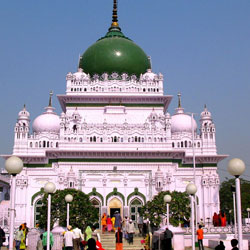
About The Dewa Sharif The Dewa Sharif is a famous shrine located in the city of Lucknow, in the state of Uttar Pradesh, India. It is dedicated to Haji Waris Ali Shah, a Sufi saint who is highly revered by followers of all faiths. The shrine is known for its peaceful and spiritual ambiance, attracting devotees from all over the country. The Dewa Sharif is not just a place of worship, but also a symbol of communal harmony, as people from different religions come together to pay their respects to the saint. Architecture of Dewa Sharif The architecture of Dewa Sharif is a blend of Mughal and Rajput styles, featuring intricate carvings, domes, and minarets. The shrine is adorned with beautiful marble work, colorful mosaic tiles, and exquisite calligraphy that highlight the spiritual significance of the place. The main prayer hall is spacious and decorated with chandeliers and Persian rugs, creating a serene atmosphere for prayer and reflection. History The Dewa Sharif was built in the 19th century in honor of Haji Waris Ali Shah, who was a renowned Sufi saint known for his piety and miracles. The shrine has since become a symbol of peace and unity, attracting thousands of pilgrims and tourists every year. The history of Dewa Sharif is deeply intertwined with the cultural and religious fabric of Lucknow, making it a significant landmark in the city's history. Best Time To Visit The best time to visit Dewa Sharif is during the annual Urs festival, which commemorates the death anniversary of Haji Waris Ali Shah. The Urs festival is a vibrant and colorful event that attracts a large number of devotees and tourists who come to pay their respects and participate in the festivities. The shrine is beautifully decorated with lights and flowers during this time, creating a festive and joyous atmosphere. How To Reach The Dewa Sharif is located about 30 kilometers away from Lucknow city center and is easily accessible by road. Visitors can take a taxi or hire a car to reach the shrine, which is well-connected by a network of roads. The nearest railway station to Dewa Sharif is Barabanki Junction, which is about 10 kilometers away. Lucknow also has an international airport, making it convenient for travelers from around the world to visit the shrine. Visitor Tips 1. Dress modestly when visiting the Dewa Sharif, as it is a place of worship. 2. Remove your shoes before entering the prayer hall and show respect for the customs and traditions of the shrine. 3. Be mindful of your behavior and maintain silence inside the shrine to allow others to pray peacefully. 4. Avoid visiting during peak hours to experience a more peaceful and serene atmosphere. 5. Carry some cash for donations or offerings at the shrine, as it is a common practice among visitors. Visiting the Dewa Sharif in Lucknow is not just a religious pilgrimage but also a cultural experience that showcases the rich heritage and traditions of the region. The shrine's architecture, history, and spiritual significance make it a must-visit destination for anyone exploring the city of Lucknow.
Explore More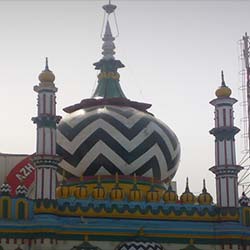
About The Dargah E Ala-Hazrat The Dargah E Ala-Hazrat is a revered Sufi shrine located in Bareilly, Uttar Pradesh, India. It is dedicated to Imam Ahmed Raza Khan, a prominent Sunni Islamic scholar and founder of the Barelvi movement. The Dargah is a significant pilgrimage site for followers of the Barelvi sect of Sunni Islam, who come from far and wide to pay their respects and seek blessings. Architecture of Dargah E Ala-Hazrat The architecture of the Dargah E Ala-Hazrat is a blend of Mughal and British colonial styles. The shrine is adorned with intricate carvings, beautiful domes, and minarets that stand tall against the sky. The main entrance is a grand gateway that leads to a courtyard surrounded by prayer halls and tombs. The interior of the Dargah is equally stunning, with ornate calligraphy and delicate designs adorning the walls and ceilings. History The Dargah E Ala-Hazrat was established in the early 20th century to honor the legacy of Imam Ahmed Raza Khan. He was a prolific scholar, theologian, and poet who wrote extensively on Islamic jurisprudence and spirituality. Imam Ahmed Raza Khan's teachings and contributions to Islamic thought continue to inspire and guide his followers to this day. Best Time To Visit The Dargah E Ala-Hazrat can be visited throughout the year, but the best time to visit is during the annual Urs festival, which commemorates the death anniversary of Imam Ahmed Raza Khan. The Urs festival is a vibrant celebration with devotional music, prayers, and feasting that attracts pilgrims and visitors in large numbers. How To Reach The Dargah E Ala-Hazrat is located in the heart of Bareilly city, making it easily accessible by road, rail, and air. The nearest airport is in Lucknow, approximately 250 kilometers away, while the Bareilly Junction railway station is well-connected to major cities across India. Local buses and taxis are also available for those traveling within the city. Visitor Tips - Dress modestly and respect the customs and traditions of the Dargah. - Remove your shoes before entering the shrine. - Seek permission before taking photographs within the premises. - Follow the instructions of the caretakers and staff at the Dargah. - Donations are welcome but not mandatory, so give as per your means. - Plan your visit during weekdays to avoid crowds and long queues.
Explore MoreMathura Goverdhan Barsana Car Tour
1 Day
Mathura - Vrindavan
5N/6D Spiritual Triangle with Naimisharanya
6 Days/ 5 Night
Lucknow - Ayodhya - Prayagraj - Varanasi - Sitapur
2D - 1N Agra Tour Package
2 Days/ 1 Night
Agra
Uttar Pradesh Spiritual Circuit-4N 5D
5 Days/ 4 Night
Ayodhya - Prayagraj - Varanasi